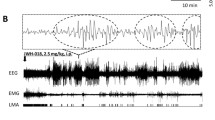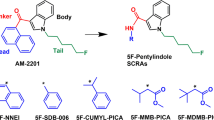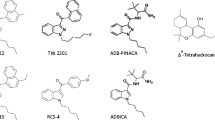Abstract
Rationale
Synthetic cannabinoid receptor agonists (SCRAs) are found in illicit smoking products, such as “K2” or “Spice.” Convulsions are commonly reported adverse effects of SCRAs but are poorly understood.
Objectives
We determined convulsant effects of SCRAs AB-PINACA, and 5F-ADB-PINACA in adult male NIH Swiss mice, and then determined if convulsant effects of AB-PINACA, 5F-AB-PINACA, 5F-ADB-PINACA, and JWH-018 elicited seizure-like effects using EEG.
Methods
Mice were administered SCRAs or pentylenetetrazole (PTZ) and placed in observation chambers where convulsant effects were scored. The capacity of the CB1R antagonist rimonabant, the benzodiazepine diazepam, or the non-specific CYP450 inhibitor 1-aminobenzotriazole (1-ABT) to attenuate convulsant effects was determined. Other mice were prepared with EEG headmounts to ascertain whether observed convulsions occurred concurrently with seizure-like effects by assessing root-mean-square (RMS) power, high amplitude EEG spike analysis, and videography.
Results
Mice receiving AB-PINACA or 5F-ADB-PINACA exhibited dose-dependent convulsant effects that were blocked by 10 mg/kg rimonabant pretreatment but not by pretreatment with 10 mg/kg diazepam; these convulsant effects were not altered in the presence of 100 mg/kg 1-ABT. Repeated administration of 10 mg/kg AB-PINACA and 3 mg/kg 5F-ADB-PINACA produced partial tolerance to convulsant effects but did not lead to cross-tolerance to PTZ-induced convulsions. In EEG studies, convulsant doses of AB-PINACA, 5F-AB-PINACA, 5F-ADB-PINACA, and JWH-018 did not produce seizures concomitantly with convulsions.
Conclusions
These data extend previous findings of convulsant effects of SCRAs and suggest that convulsant effects of AB-PINACA, 5F-AB-PINACA, 5F-ADB-PINACA, and JWH-018 are CB1R-mediated but are not associated with electroencephalographic seizures. These results further suggest that benzodiazepines may not effectively treat convulsions elicited by SCRA use in humans.









Similar content being viewed by others
Abbreviations
- CB1Rs:
-
CB1 cannabinoid receptors
- CB2Rs:
-
CB2 cannabinoid receptors
- THC:
-
Δ9-Tetrahydrocannabinol
- PTZ:
-
Pentylenetetrazol
- JWH-018:
-
1-Naphthalenyl(1-pentyl-1H-indol-3-yl)-methanone
- rimonabant:
-
5-(4-Chlorophenyl)-1-(2,4-dichloro-phenyl)-4-methyl-N-(piperidin-1-yl)-1H-pyrazole-3-carboxamide
- AB-PINACA:
-
(S)-N-(1-amino-3-methyl-1-oxobutan-2-yl)-1-pentyl-1H-indazole-3-carboxamide
- 5F-ADB-PINACA:
-
N-[1-(aminocarbonyl)-2,2-dimethylpropyl]-1-(5-fluoropentyl)-1H-indazole-3-carboxamide
- 5F-AB-PINACA:
-
N-[(2S)-1-amino-3-methyl-1-oxobutan-2-yl]-1-(5-fluoropentyl)indazole-3-carboxamide
- EEG:
-
Electroencephalography
- RMS:
-
Root-mean-square
References
Andreias L, Roffe E, Eng A et al (2020) Synthetic cannabinoid receptor agonists-induced recurrent seizure in elderly patient. Am J Emerg Med 38(4):850.e5-850.e6
Arabadzhiev TI, Dimitrov VG, Dimitrova NA et al (2010) Interpretation of EMG integral or RMS and estimates of “neuromuscular efficiency” can be misleading in fatiguing contraction. J Electromyogr Kinesiol 20(2):223–232
Aung MM, Griffin G, Huffman JW et al (2000) Influence of the N-1 alkyl chain length of cannabimimetic indoles upon CB (1) and CB (2) receptor binding. Drug Alcohol Depend 60(2):133–140
Barker-Haliski M, White HS (2015) Glutamatergic mechanisms associated with seizures and epilepsy. Cold Spring Harb Perspect Med 5(8):a022863
Braakman HM, van Oostenbrugge RJ, van Kranen-Mastenbroek VH et al (2009) Rimonabant induces partial seizures in a patient with a history of generalized epilepsy. Epilepsia 50(9):2171–2172
Breivogel CS, Wells JR, Jonas A et al (2020) Comparison of the neurotoxic and seizure-inducing effects of synthetic and endogenous cannabinoids with ∆9-tetrahydrocannabinol. Cannabis Cannabinoid Res 5(1):32–41
Brents LK, Reichard EE, Zimmerman SM et al (2011) Phase I hydroxylated metabolites of the K2 synthetic cannabinoid JWH-018 retain in vitro and in vivo cannabinoid 1 receptor affinity and activity. PLoS ONE 6(7):e21917
Buck KJ, Hahner L, Sikela J et al (1991) Chronic ethanol treatment alters brain levels of gamma-aminobutyric acidA receptor subunit mRNAs: relationship to genetic differences in ethanol withdrawal seizure severity. J Neurochem 57(4):1452–1455
Canazza I, Ossato A, Trapella C et al (2016) Effect of the novel synthetic cannabinoids AKB48 and 5F-AKB48 on “tetrad”, sensorimotor, neurological and neurochemical responses in mice. In vitro and in vivo pharmacological studies. Psychopharmacology (Berl) 233(21–22):3685–3709
Canazza I, Ossato A, Vincenzi F et al (2017) Pharmaco-toxicological effects of the novel third-generation fluorinate synthetic cannabinoids, 5F-ADBINACA, AB-FUBINACA, and STS-135 in mice. In vitro and in vivo studies. Hum Psychopharmacol. 32(3):2601
Carlier J, Diao X, Scheidweiler KB et al (2017) Distinguishing intake of new synthetic cannabinoids ADB-PINACA and 5F-ADB-PINACA with human hepatocyte metabolites and high-resolution mass spectrometry. Clin Chem 63(5):1008–1021
Castellani SA, Ellinwood EH, Kilbey MM (1978) Tolerance to cocaine-induced convulsions in the cat. Eur J Pharmacol 47(1):57–61
Cozart MA, Phelan KD, Wu H et al (2020) Vascular smooth muscle TRPC3 channels facilitate the inverse hemodynamic response during status epilepticus. Sci Rep 10:812
Craft RM, Wakley AA, Tsutsui KT, Laggart JD (2012) Sex differences in CB1 vs. CB2 receptor-selective antagonism of antinociception produced by delta-9-THC and CP55,490 in the rat. J Pharmacol Exp Ther 340:787–800
Craft RM, Kandasamy R, Davis SM (2013) Sex differences in anti-allodynic, anti-hyperalgesic and anti-edema effects of Δ(9)-tetrahydrocannabinol in the rat. Pain 154:1709–1717
Crespillo A, Suárez J, Bermúdez-Silva FJ et al (2011) Expression of the cannabinoid system in muscle: effects of a high-fat diet and CB1 receptor blockade. Biochem J 433(1):175–185
de Havenon A, Chin B, Thomas KC et al (2011) The secret “spice”: an undetectable toxic cause of seizure. Neurohospitalist 1(4):182–186
Devinsky O, Patel AD, Thiele EA et al (2018) Randomized, dose-ranging safety trial of cannabidiol in Dravet syndrome. Neurology 90(14):e1204–e1211
Diana MA, Marty A (2004) Endocannabinoid-mediated short-term synaptic plasticity: depolarization-induced suppression of inhibition (DSI) and depolarization-induced suppression of excitation (DSE). Br J Pharmacol 142(1):9–19
Elmore JS, Baumann MH (2018) Repeated exposure to the “Spice” cannabinoid JWH-018 induces tolerance and enhances responsiveness to 5-HT1A receptor stimulation in male rats. Front Psychiatry 9:55
Fantegrossi WE, Moran JH, Radominska-Pandya A et al (2014) Distinct pharmacology and metabolism of K2 synthetic cannabinoids compared to ∆9-THC: mechanism underlying greater toxicity? Life Sci 97(1):45–54
Farfán FD, Politti JC, Felice CJ (2010) Evaluation of EMG processing techniques using information theory. BioMed Eng OnLine 9:72
Funada M, Takebayashi-Ohsawa M (2018) Synthetic cannabinoid AM 2201 induces seizures: involvement of cannabinoid CB1 receptors and glutamatergic transmission. Toxicol Appl Pharmacol 338:1–8
Ginsburg BC, Schulze DR, Hruba L et al (2012) JWH-018 and JWH-073: ∆9-tetrahydrocannabinol-like discriminative stimulus effects in monkey. J Pharm Exp Ther 340(1):37–45
Gobira PH, Vilela LR, Gonҫalves BD et al (2015) Cannabidiol, a cannabis sativa constituent, inhibits cocaine-induced seizures in mice: possible role of the mTOR pathway and reduction in glutamate release. Neurotoxicology 50:116–121
Gomez DM, Everett TJ, Hamilton LR et al (2021) Chronic cannabinoid exposure produces tolerance to the dopamine releasing effects of WIN 55,212–2 and heroin in adult male rats. Neuropharmacology 182:108374
Gu B, Zhu M, Glass MR et al (2019) Cannabidiol attenuates seizures and EEG abnormalities in Angelman syndrome model mice. J Clin Invest 129(12):5462–5467
Gugelmann H, Gerona R, Li C et al (2014) ‘Crazy Monkey’ poisons man and dog: human and canine seizures due to PB-22, a novel synthetic cannabinoid. Clin Toxicol 52(6):635–638
Hermans B, Vink AS, Bennis FC et al (2017) The development and validation of an easy to use automatic QT-interval algorithm. PLoS ONE 12(9):e0184352
Hill AJ, Mercier MS, Hill TD et al (2012) Cannabidivarin is anticonvulsant in mouse and rat. Br J Pharmacol 167(8):1629–1642
Hill TDM, Cascio MG, Romano B et al (2013) Cannabidivarin-rich cannabis extracts are anticonvulsant in mouse and rat via a CB1 receptor-independent mechanism. Br J Pharmacol 170(3):679–692
Hoffman AF, Lycas MD, Kaczmarzyk JR et al (2017) Disruption of hippocampal synaptic transmission and long-term potentiation by psychoactive synthetic cannabinoid ‘Spice’ compounds: comparison with ∆9-tetrahydrocannabinol. Addict Biol 22(2):390–399
Hruba L, McMahon LR (2017) Apparent affinity estimates and reversal of the effects of synthetic cannabinoids AM-2201, CP-47,497, JWH-122, and JWH-250 by rimonabant in rhesus monkeys. J Pharm Exp Ther 362(2):278–286
Huizenga MN, Sepulveda-Rodriguez A, Forcelli PA (2019) Preclinical safety and efficacy of cannabidivarin for early life seizures. Neuropharmacology 148:189–198
Hutchison RD, Ford BM, Frank LN et al (2018) Atypical pharmacodynamic properties and metabolic profile of the abused synthetic cannabinoid AB-PINACA: potential contribution to pronounced adverse effects relative to ∆9-THC. Front Pharmacol 9:1084
Hutter M, Broecker S, Kneisel S et al (2012) Identification of the major urinary metabolites in man of seven synthetic cannabinoids of the aminoalkylindole type present as adulterants in ‘herbal mixtures’ using LC-MS/MS techniques. J Mass Spectrom 47(1):54–65
Jones NA, Hill AJ, Smith I et al (2010) Cannabidiol displays antiepileptiform and antiseizure properties in vitro and in vivo. J Pharm Exp Ther 332(2):569–577
Kaplan JS, Stella N, Catterall WA et al (2017) Cannabidiol attenuates seizures and social deficits in a mouse model of Dravet syndrome. Proc Natl Acad Sci USA 114(42):11229–11234
Kevin RC, Anderson L, McGregor IS et al (2019) CUMYL-4CN-BINACA is an efficacious and potent pro-convulsant synthetic cannabinoid receptor agonist. Front Pharmacol 10:595
King A (2010) Neuropsychiatric adverse effects signal the end of the line for rimonabant. Nat Rev Cardiol 7:602
Koo CM, Kim SH, Lee JS et al (2020) Cannabidiol for treating Lennox-Gastaut syndrome and Dravet syndrome in Korea. J Korean Med Sci 35(50):e427
Krauss P, Schilling A, Bauer J et al (2018) Analysis of multichannel EEG patterns during human sleep: a novel approach. Front Hum Neurosci 12:121
Lapoint J, James LP, Moran CL et al (2011) Severe toxicity following synthetic cannabinoid ingestion. Clin Toxicol (phila) 49(8):760–764
Laux LC, Bebin EM, Checketts D et al (2019) Long-term safety and efficacy of cannabidiol in children and adults with treatment resistant Lennox-Gastaut syndrome or Dravet syndrome: expanded access program results. Epilepsy Res 154:13–20
Longworth M, Connor M, Banister SD et al (2017) Synthesis and pharmacological profiling of the metabolites of synthetic cannabinoid drugs APICA, STS-135, ADB-PINACA, and 5F-ADB-PINACA. ACS Chem Neurosci 8(8):1673–1680
Lux RL, Sower CT, Allen N et al (2014) The application of root mean square electrocardiography (RMS ECG) for the detection of acquired and congenital long QT syndrome. PLoS ONE 9(1):e85689
Lϋttjohann A, Fabene PF, van Luijtelaar G (2009) A revised Racine’s scale for PTZ-induced seizures in rats. Physiol Behav 98(5):579–586
Malyshevskaya O, Aritake K, Kaushik MK et al (2017) Natural (∆9-THC) and synthetic (JWH-018) cannabinoids induce seizures by acting through the cannabinoid CB1 receptor. Sci Rep 7(1):10516
Mann K, Bäcker P, Röschke J (1993) Dynamical properties of the sleep EEG in different frequency bands. Int J Neurosci 73(3–4):161–169
Marsicano G, Lutz B (1999) Expression of the cannabinoid receptor CB1 in distinct neural subpopulations in the adult mouse forebrain. Eur J Neurosci 11(12):4213–4225
Matsuzaki M (1978) Alteration in pattern of EEG activities and convulsant effect of cocaine following chronic administration in the rhesus monkey. Electroencephalogr Clin Neurophysiol 45(1):1–15
Melis M, Pistis M, Perra S et al (2004) Endocannabinoids mediate presynaptic inhibition of glutamatergic transmission in rat ventral tegmental area dopamine neurons through activation of CB1 receptors. J Neurosci 24(1):53–62
Naydenov AV, Horne EA, Cheah CS et al (2014) ABHD6 blockade exerts antiepileptic activity in PTZ-induced seizures and in spontaneous seizures in R6/2 mice. Neuron 83(2):361–371
Park EJ, Park R, Jeon JH et al (2020) Inhibitory effect of AB-PINACA, indazole carboxamide synthetic cannabinoid, on human major drug-metabolizing enzymes and transporters. Pharmaceutics 12(11):1036
Phelan KD, Shwe UT, William DK et al (2015) Pilocarpine-induced status epilepticus mice: a comparison of spectral analysis of electroencephalogram and behavioral grading using the Racine scale. Epilepsy Res 117:90–96
Phelan KD, Shwe UT, Cozart MA et al (2017) TRPC3 channels play a critical role in the theta component of pilocarpine-induced status epilepticus in mice. Epilepsia 58(2):247–254
Rajasekaran M, Brents LK, Franks LN et al (2013) Human metabolites of synthetic cannabinoids JWH-018 and JWH-073 bind with high affinity and act as potent agonists at cannabinoid type-2 receptors. Toxicol Appl Pharmacol 269(2):100–108
Rajesh M, Bátkai S, Kechrid M et al (2012) Cannabinoid 1 receptor promotes cardiac dysfunction, oxidative stress, inflammation, and fibrosis in diabetic cardiomyopathy. Diabetes 61(3):716–727
Riegel AC, Lupica CR (2004) Independent presynaptic and postsynaptic mechanisms regulate endocannabinoid signaling at multiple synapses in the ventral tegmental area. J Neurosci 24(49):11070–11078
Romero E, Fernández B, Sagredo O, Gomez N, Urigüen L, Guaza C et al (2002) Antinociceptive, behavioural and neuroendocrine effects of CP 55,940 in young rats. Brain Res Dev Brain Res 136:85–92
Schneir AB, Baumbacher T (2012) Convulsions associated with the use of a synthetic cannabinoid product. J Med Toxicol 8(1):62–64
Schwartz MD, Trecki J, Edison LA et al (2015) A common source outbreak of severe delirium associated with exposure to the novel synthetic cannabinoid ADB-PINACA. J Emerg Med 48(5):573–580
Shimosato K, Watanabe S, Marley RJ et al (1996) One-way cross-sensitization and cross-tolerance to seizure activity from cocaine to lidocaine. Ann NY Acad Sci 801:340–352
Srisung W, Jamal F, Prabhakar S (2015) Synthetic cannabinoids and acute kidney injury. Proc (baylor Univ Med Cent) 28(4):475–477
Storr M, Sibaev A, Marsicano G et al (2004) Cannabinoid 1 receptor type-1 modulates excitatory and inhibitory neurotransmission in mouse colon. AM J Physiol Gastrointest Liver Physiol 286(1):G110–G117
Straiker AJ, Maguire G, Mackie K et al (1999) Localization of cannabinoid CB1 receptors in the human anterior eye and retina. Invest Ophthalmol vis Sci 40(10):2442–2448
Tait RJ, Caldicott D, Mountain D et al (2016) A systematic review of adverse events arising from the use of synthetic cannabinoids and their associated treatment. Clin Toxicol 54(1):1–13
Tatusov M, Mazer-Amirshahi M, Abbasi A et al (2019) Clinical effects of reported synthetic cannabinoid exposure in patients admitted to the intensive care unit. Am J Emerg Med 37(6):1060–1064
Tseng A, Craft R (2001) Sex differences in antinociceptive and motoric effects of cannabinoids. Eur J Pharmacol 430:41–47
Van Erum J, Van Dam D, Deyn De, pp. (2019) PTZ-induced seizures in mice require a revised Racine scale. Epilepsy Behav: E&B. 95:51–55
Vilela LR, Lima IV, Kunsch EB et al (2017) Anticonvulsant effects of cannabidiol in the pentylenetetrazol model: pharmacological mechanisms, electroencephalographic profile, and brain cytokine levels. Epilepsy Beh: e&b 75:29–35
Weed PF, Filipeanu CM, Ketchum MJ, Winsauer PJ (2016) Chronic Δ9-tetrahydrocannabinol during adolescence differentially modulates striatal CB1 receptor expression and the acute and chronic effects on learning in adult rats. J Pharmacol Exp Ther 356:20–31
Wiley JL, Lefever TW, Marusich JA, Craft RM (2017) Comparison of the discriminative stimulus and response rate effects of Δ9-tetrahydrocannabinol and synthetic cannabinoids in female and male rats. Drug Alcohol Depend 172:51–59
Wilson CD, Tai S, Ewing L et al (2019) Convulsant effects of abused synthetic cannabinoids JWH-018 and 5F-AB-PINACA are mediated by agonist actions at CB1 receptors in mice. J Pharm Exp Ther 368(2):146–156
Wohlfarth A, Castaneto MS, Zhu M et al (2015) Pentylindole/pentylindazole synthetic cannabinoids and their 5-fluoro analogs produce different primary metabolites: metabolite profiling for AB-PINACA and 5F-AB-PINACA. AAPS J 17(3):660–677
Wolfe CE, Wood DM, Dines A et al (2019) Seizures as a complication of recreational drug use: analysis of the Euro-DEN Plus data-set. Neurotoxicology 73:183–187
Zaurova M, Hoffman RS, Vlahov D et al (2016) Clinical effects of synthetic cannabinoid receptor agonists compared with marijuana in emergency department patients with acute drug overdose. J Med Toxicol 12(4):335–340
Acknowledgements
We thank the UAMS Division of Laboratory Animal Medicine for their expert husbandry services. We also thank Thomas Prisinzano in the Department of Medicinal Chemistry at the University of Kansas School of Pharmacy for providing rimonabant as a generous gift.
Funding
This work was supported in part by the National Institutes of Health National Institute on Drug Abuse [Grants DA039143 and DA022981], by the National Institute on General Medical Sciences [IDeA Program award GM110702], by the Drug Enforcement Administration [HHSF223201610079C], and by the UAMS Translational Research Institute [RR029884].
Author information
Authors and Affiliations
Corresponding author
Ethics declarations
Conflict of interest
The authors declare no competing interests.
Additional information
Publisher's note
Springer Nature remains neutral with regard to jurisdictional claims in published maps and institutional affiliations.
Rights and permissions
Springer Nature or its licensor holds exclusive rights to this article under a publishing agreement with the author(s) or other rightsholder(s); author self-archiving of the accepted manuscript version of this article is solely governed by the terms of such publishing agreement and applicable law.
About this article
Cite this article
Wilson, C.D., Zheng, F. & Fantegrossi, W.E. Convulsant doses of abused synthetic cannabinoid receptor agonists AB-PINACA, 5F-AB-PINACA, 5F-ADB-PINACA and JWH-018 do not elicit electroencephalographic (EEG) seizures in male mice. Psychopharmacology 239, 3237–3248 (2022). https://doi.org/10.1007/s00213-022-06205-6
Received:
Accepted:
Published:
Issue Date:
DOI: https://doi.org/10.1007/s00213-022-06205-6




